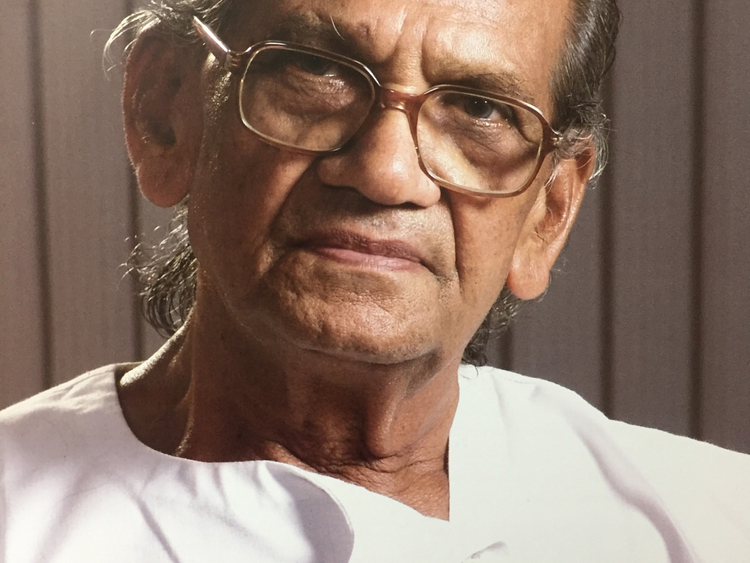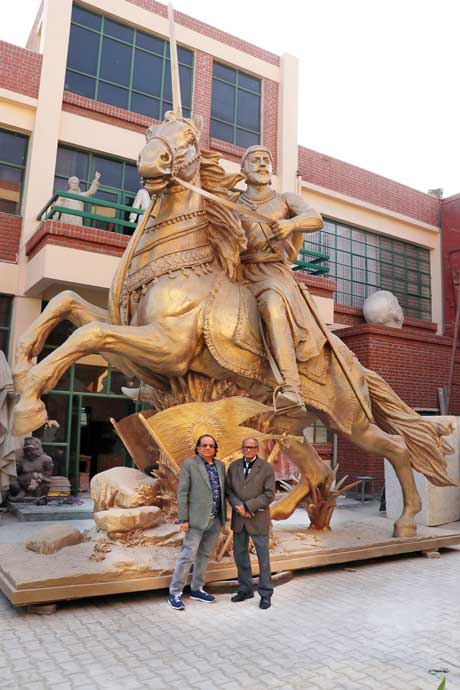Ram Sutar |
For 70 years, sculptor Ram Sutar has been breathing life into inanimate objects. Chiselling and carving out every curve carefully, he has hundreds of sculptures to his credit. Having received the Padma Bhushan (2016) and Padma Shree (1999) awards for his contribution to the field of arts, the 92-year-old sculptor is getting set to work on a gigantic statue of Chhatrapati Shivaji. In December, Indian Prime Minister Narendra Modi laid the foundation stone for the grand memorial of the Maratha warrior king Shivaji off the Mumbai coast in the Arabian Sea.
The statue of Shivaji, a 17th century Hindu ruler, will be more than twice the size of the Statue of Liberty in the United States and five times higher than the Christ the Redeemer in Rio de Janeiro. Set to be the world’s tallest statue, it will rise 192 metres, with its pedestal housing museums, auditoriums, libraries and cafes. The project, costing around Rs36 billion (Dh2 billion), is scheduled to be completed by 2019.
According to Modi, “Even in the midst of struggle, Shivaji Maharaj remained a torchbearer of good governance. So many aspects of his personality inspire us.” Shivaji is revered by many in Maharashtra state, and Mumbai’s airport and main railway station are both named after the ruler.
“We had made seven models out of which the present one was finally selected,” says Sutar, who still works at least six to eight hours a day. “It has the horse standing on its hind legs, depicting a running form. Shivaji’s face has a victorious smile and he is brandishing a sword. The exterior of the statue will be made of bronze and the interior framework will be built of steel and concrete. To finish the work within two years, we will have to employ over 2,000 workers and work 24 hours a day.”
The sculptor’s works can be seen in several of the country and practically every Indian state showcases one of Sutar’s moulds, be it a prominent personality or a political leader. His sculptures have also reached overseas including the US, UK, France, Italy, Argentina, Japan, Australia, Russia, China, Germany and several African countries.
He works out of a studio built on a 2,000 squate metre plot in Noida, Uttar Pradesh, and also owns a foundry set up in a 8,000 square metre area. Located in Sahibabad, Uttar Pradesh, it has the capacity for 1000kg of casting in a day.
Before setting up these locations, Sutar sculpted his statues at the Buddha Gardens in New Delhi for about four years until he was asked to vacate the premises. “I found the environs very peaceful and feel artists should be allotted some areas in forests and greens for their creativity to blossom,” he says.
Born on February 19, 1925, Sutar, who hails from Gondur village in Maharashtra’s Dhulia district, is one of four sons from a carpenter’s family. Right from childhood, he was very good at drawing. His talent did not go unnoticed and his teacher, Sriram Krishna Joshi, encouraged Sutar a lot, even pressuring him into enroll in higher education.
Joshi later helped Sutar join the Sir J J School of Arts in Mumbai, where he studied from 1948 to 1952. He stood first in the class throughout, eventually bagging the much-coveted Mayo Gold Medal in modelling and sculpting.
The inspiration he got from his mentor made him a master in all mediums — be it stone, marble, bronze, brass, stainless steel or fibreglass. Ever grateful to Joshi, Sutar says, “Had it not been for him, it would have been impossible for me to reach such heights and get such prestigious works.”
From 1954 to 1958, Sutar worked in the department of archaeology in Aurangabad as a modeler for restoration work on the Ajanta and Ellora sculptures. This was followed by joining the Department of Audio-Visual Publicity in the Ministry of Information and Broadcasting, New Delhi, as a technical assistant in the Exhibition Division. He worked there for a year and soon the artist in him took over. Refusing to let his creativity be subsumed, he quit the job to become a full-time sculptor.
“I got assignments to do two sculptures for an agriculture fair at Pragati Maidan in New Delhi and since that day, I have never been without work,” he says.
Sutar’s first notable work was the 45-feet Chambal monument at the Gandhi Sagar Dam in Madhya Pradesh. Carved out of a single block, it depicts mother Chambal with her two children, Madhya Pradesh and Rajasthan, symbolising the brotherhood of the two states.
Sutar has made more than 600 life-sized sculptures, including Mahatma Gandhi’s statue in meditation pose at Parliament House in New Delhi. His monumental creations include statues of Pt Govind Ballabh Pant, Pt Jawaharlal Nehru, Indira Gandhi, Netaji Subhash Chandra Bose, Loknayak Jai Prakash Narayan, Prithviraj Chauhan and Shaheed Bhagat Singh.
“At one time, I dreamt of visiting foreign shores to see the mammoth works which always fascinated me,” Sutar reminisces. “As a teenager, I was impressed by Western sculptures, but later the splendour of the Ajanta and Ellora influenced my style.”
His dedication towards his work is such that despite having several workers to assist him, he still handles the artistic work on his own. As Sutar says, “Sculpting is an art and a sculptor has to go through the complete personality of the person, understand his character, qualities, other traits, [and] the works done by him with the help of photographs [and] drawings.”
Content with his life, he says, “I have always believed in looking ahead. Out of nothingness I have derived a lot and will continue to work as long as I can.”
His son, Anil, a sculptor and architect, has followed his father’s footsteps. With a Bachelor of Architecture from the School of Planning and Architecture, New Delhi and a Masters in Architecture and Urban Design from Washington University, St Louis, Missouri, Anil has been making portraits and sculptures, some of which are displayed in the US, the Middle East and Nigeria.
“Since 1994, I have been working along with my father and together we have expanded the infrastructure.” Anil says. “As a team, we are presently working on the 522 foot world’s biggest statue of Sardar Vallabhbhai Patel in bronze to be installed at Sardar Sarovar Dam in Gujarat.”
The 59-year-old points out that: “Monuments are very important to build the collective conscience of a country. These are places where people gather, and in a way, it helps in keeping a particular incident in history or an important person in the memory of the visitors.”
While the son is sculpting his own path, the father says, “Other than the Shivaji statue, which we would shortly be working on, my long cherished dream is to sculpt a world famous monumental structure.” So, does he have a concept? “Of course, yes! I have even named it — Progress,” Sutar says enthusiastically.
The miniature model of ‘Progress’ he has designed depicts how a man climbs the ladders of life to reach higher goals. With this, the sculptor hopes to set another benchmark.
Nilima Pathak is a journalist based in New Delhi.














